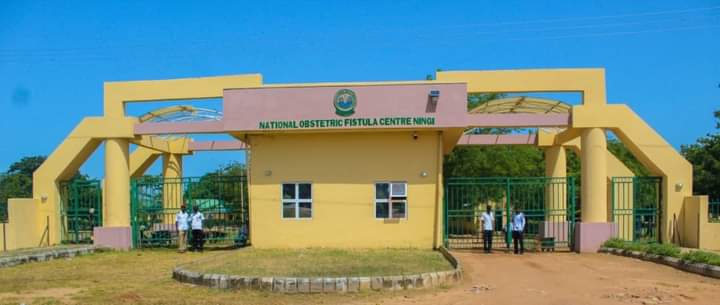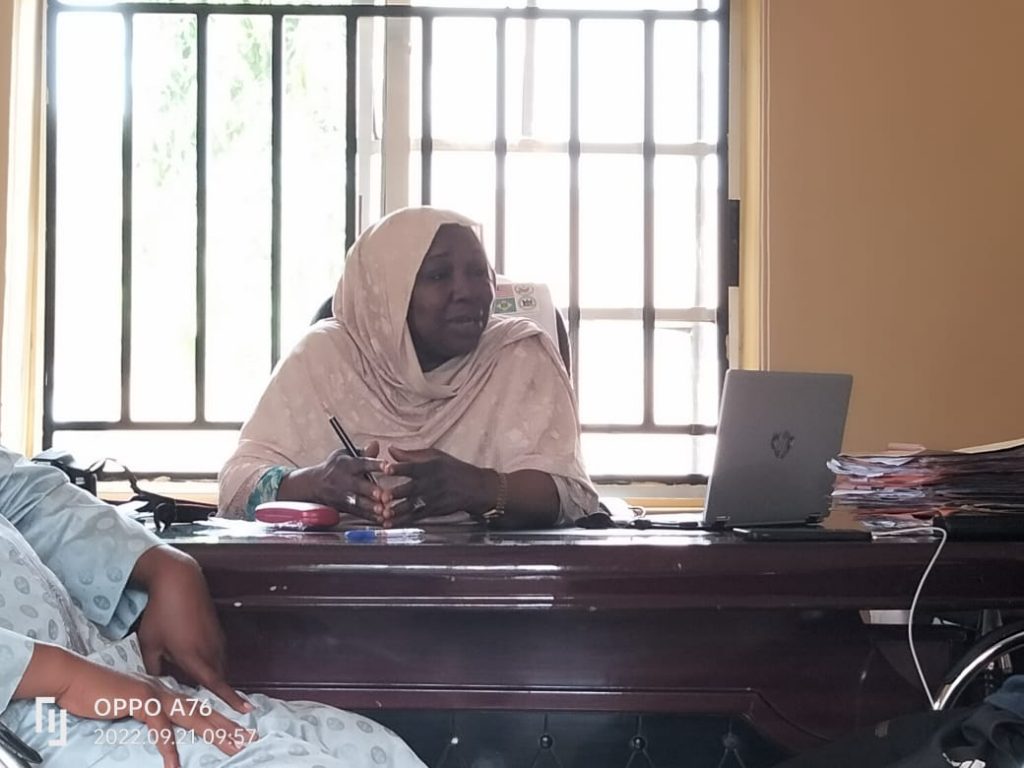In this report, Hamzat Ibrahim Abaga tells the story of how women living with Vesicovaginal Fistula (VVF) and Obstetric Fistula (OF) in Bauchi State are being neglected by their families amid stigmatization by the public.
After 15 unsuccessful operations in Plateau and Buchi states, Fatima Hassan, 70, would get rid of her fistula at the National Obstetric Fistula Centre (NOFIC) in Ningi, Bauchi State.
The septuagenarian told Xchange Hama Media she was 25 years old when she had prolonged child labour leading to the disease, a stigma she lived with for about three decades.
Fatima was told she has an obstetrics fistula when she couldn’t stop passing urine after delivery. Sadly, the baby later passed away.
After getting rid of the stigma, Fatima was rehabilitated at NOFIC where she was serving as a cook. Cooking and serving other victims of VVF and OF is what she does for a living. Fatima does this, happily, she told Xchange Hama Media.
“When some of these victims come to pick their foods here in the kitchen, some said they are tired and willing to let go of their lives after two to three operations and I will tell them my story of being operated on 16 times and advise them that the end will definitely come,” she said.
Although, she admitted she was once in their shoes. Life with a fistula could be more frustrating than that, she believes. The old woman would regain herself after 30 surgeries.
Fatima Hassan, 70 years old woman who gets rid of her fistula after 15 operations
According to National Library of Medicine, obstetric fistula (OF) is an “abnormal opening between a woman’s vagina and bladder and/or rectum through which urine (vesicovaginal fistula) and/or faeces (recto-vaginal fistula) continually leak,” a medical condition in which a hole develops in the birth canal in the course of prolonged childbirth.
With the burden of OF high in Nigeria, It was reported that in march 2022, over 50 women living with Vesicovaginal Fistula (VVF) in Bauchi State communities were successfully treated in the Gamawa and Ningi local government councils.
As popularly held, child marriage is not the only cause of the disease, according to medical experts. A woman could contact fistula during child labour — in some cases, after several successful childbirth. Other causes are barbaric cultural beliefs/practices such as genital mutilation.
Against the neglect the victims suffer, Xchange Hama Media learnt that the disease could be treated through surgery and medications.
Hafsat, Halima– VVF Victims, Symbols of neglect
Unlike Fatima who could be considered a little bit lucky, Hafsat Musa, 19 and Halima Mohammed 16, who all got married at the age of 12 and 14, developed fistula during their first childbearing. Although she lives several kilometres apart, they share a lot in common. They both gave birth to dead babies, suffered excruciating pains and ended up suffering from OF. Hafsat narrated how her husband’s neglect worsened her condition.

Aside from constant urine leakage, the 19-year-old lady also suffers shame, social segregation and much more.
“When the problem of fistula first started, I was taken to a nearby healthcare centre in Tauya, Darazo LGA,” she relieved. “Afterwards, I was operated on, and after several operations within the period of five days, the situation kept retrogressing.”
Musa, her husband, had only visited Hafsat once. “He only came once and gave N2,500,” she mumbled. “He neither calls to check on me.”
Fatima on the other hand had a much more terrible ordeal. “My husband completely abandons me; not only did he abandon me, but I was also told that he was planning to marry a second wife”, she said as tears rolled down her cheeks.
Fatima told Xchange Hama that apart from the pains and disgust associated with OF, the constant thought of discrimination and social segregation by her husband and his relatives was another inconceivable pain she lives with. “For me, the neglect I suffer from people that ought to be of help to me was more painful than the ailment that struck me; the most horrible condition any living being will suffer on earth is the neglect of close relatives and people you love most. Everything in this world revolves around love and affection, when you don’t have it, that is the end of the world for you”, Fatima narrates as she constantly weeps.
Fatima and Hafsat toxic experiences are a symbolic posture of how women suffering from Vesico Varginal Fistula are treated in Bauchi and beyond. They suffer endless discrimination, lack proper medical attention and are inflicted with lifetime psychological trauma– many of them perish in the process.
Several research findings suggest VVF remains a major nightmare for women in Nigeria. For instance, the Pan African Medical Journal, states that the prevalence of obstetric fistula is 3.2 per 1000 births and it was estimated that about 13, 000 new cases occur annually. The data indicates that the backlog of unrepaired cases may take about 83 years to clear at such a present rate of repair.
Additionally, the United Nations International Children’s Emergency Fund reported that Nigerian women currently living with VVF range from 400,000 to 800,000 and annually, an additional 50,000 to 100,000 new cases occur in Nigeria.
Figures suggest 3.2 persons per 1,000 from our population are faced with fistula annually, with at least 33,000 of these being found in sub-Saharan Africa.
A Baby Could Be Born With Fistula
A three-year-old girl (name withheld) was still breastfeeding when her family noticed her abnormal urine leakage. But they felt it was normal.
“She was three years old,” said her grandmother. “We noticed unusual urination from her since she was little, but we overlooked it, thinking it was a minor case which would stop very soon. Now we have to find our way to the hospital for a remedy.”
Dr. Opkara Edward Olarewaju, the Acting Head of Clinicals, NOFIC Ningi, said there are scenarios that could endanger a newborn with a fistula.
“It might be congenital which occurs during childbirth when a baby could accidentally be born due to the condition of the baby’s mother’s private part,” he explained. “There are also other causes like trauma, where a baby might fall and sustain injuries in her private part or the baby while playing might step at a sharp object and get her fistula damage.
“It could be as a result of female genital mutilation through traditional where the child blader can be mistakenly damaged in the process.”
I was speaking on how VVF can be treated. Olarewaju said there are mainly two types of treatments, consavatitive and definitive.
He, however, referred to conservative as cardiac treatment, and he said it is a process when VVF is treated by catching the fistula young and it passes through what is called cativa and in open treatment for some weeks to allow the fistula to heal.
“In consavative treatment, there is 75% assurance of the patient to get healed,” he explained. “Definitive treatment is when treatment of VVF is done through surgical intervention. Also, In this process when a patient works in the hospital, she gets admitted, Doctors do the necessary check-ups and the patient undergoes surgery.”
The Managing Director, NOFIC Ningi, Dr. Halima Mukaddas in an interview with Xchange Hama Media said that the centre only has three mandates; training, research and treatment/rehabilitation of fistula patients.
Mukaddas described fistula as a “terrible condition”, caused by childbirth and obstructed labour, child marriage, immature pregnancy, and genital mutilations.
“In a time of prevention, parents must allow their female child to grow very well before getting married. And if married and got pregnant, the husband must prioritize proper nutrition for his wife,” she said.
She also added that qualified personnel must be allowed to monitor or attend to women during childbirth to prevent unforeseen circumstances that might damage her bladder and lead to fistula.
“Access to hospital facilities and poor hospital facilities can as well cause obstructed labour which might lead to developing fistula. So at all times, the government must make available the necessary and needed resources at our hospitals to prevent such kinds of issues,” she stated.
The Bauchi Case
In Bauchi State, Xchange Mama can report that the National Obstetric Fistula Centre, (NOFIC) repairs between 400 and 500 fistula cases annually, with some done on routine bases, while others are gathered in groups of about 100 at a time. About 2,000 people are currently living with VVF disease in Bauchi State.
The Bauchi case is a replica of the situation nationwide. Although there is no exact data on the incidence or prevalence of fistula in Bauchi, the state does host the National Obstetric Fistula Centre through the USAID Fistula Care Plus initiative and provides education, outreach, and free fistula repairs in the state.
Findings suggest the hospital has four surgeons trained in fistula repair and carried out 187 surgical repairs in 2016.
The majority of fistula patients in Bauchi State and North Eastern Nigeria had no formal education (81.3%), were mostly housewives (80%), and lived in rural areas (77.3%). About half of the studied population were teenagers and are not living with their husbands anymore as a result of the infection.
The existence of such a high number of obstetric fistula victims has highlighted the failure of health systems to provide high-quality maternal health care including skilled medical attention and timely emergency obstetric care. It is also a reflection of the socio-economic, regional and gender-based inequities as well as the patriarchal nature of African societies that hinder women from accessing high-quality services.
The Bauchi case is more compounded by years of system failure, inadequate budgetary allocations and timely releases to treat patients as well as lack of information flow that should create the necessary behaviour change communication to dissuade people and the larger society from discriminating against VVF patients.
Findings by Exchange Mama Media also indicate that apart from the location of the VVF facility provided by the Bauchi state government in Ningi, there is no intervention by the state government for patients living with the ailment. Although sometimes there is negligible, often symbolic help from the office of the first of the state.
The consequences of OF Among Women
VVF is a life-threatening ailment for many women. Tellingly, it could quickly and prematurely terminate its victim’s life or leave them with trauma till the end.
Ifeoma Okoye, Professor of Radiology and Director University of Nigeria, Centre for Clinical Trials -UNNCECT, & Founder /Co-Chair African Clinical Trial Consortium, said that Fistula has a very high tendency to cause suicide among victims.
She said lack of proper information and access to quality medical care to repair and bring back the victims to society, could prematurely end their lives or subject them to lifetime symbols of public discrimination and pity. Okoye also argued that neglected fistula victims will always be a significant burden on society.
“Of course, we know without information and access to the medical care that is available to repair and reestablish them (fistula victims) back to normal life, they (fistula victims) will remain abandoned and with time they either die or become beggars”.
A glimpse of hope
The Managing Director, NOFIC Ningi, Dr. Halima Mukaddas said although the situation in Bauchi State was quite worrisome, a glimpse of hope for the victims is evident, looking at the series of interventions and attention the centre is getting.
Dr Mukkadas said the federal government has made it an annual routine by organizing training and retraining of the medical and non-medical staff with the required knowledge for the smooth running of activities at the centre.

She added that other medical and non-medical staff outside the state also participated in training and retraining organized by the federal government of Nigeria.
Also, the federal government in collaboration with the state government has trained their staff about fistula, to be able to perform simple operations of fistula cases. The training also houses counselling, which she says will help reduce the psychological effect of OF.
Mukaddas however called on the Bauchi State government to further strengthen their collaboration with the centre because 70 to 80 percent of fistula cases recorded at the centre are residents of Bauchi state.
“Our major challenges at the centre are funding, going around the facility someone will notice that there are uncompleted structures which if completed will boost the operations of the centre, let both federal and state government help in completing the structure so that the facility centre operate optimally.
“Developing and implementing guidelines on the management of obstructed labour and the management of women who present with obstetric fistula immediately after birth or who present with an established fistula requiring repairs. This and many more would help in achieving a great result in the fight against fistula”, Mudakkas said.
The social welfare unit of the NOFIC centre in Ningi also explains the steps the centre was taking to help victims of OF.
Sani Mohammed the Unit Head of Social Welfare Service NOFIC, confirmed that more awareness creation was done across LGAs identified as flashpoints.
“The team of Social Welfare Service often took to the local governments identify as the hotspot of the fistula patients to create more awareness, educate and educate the locals including the village heads of the affected community on some practices considered as the major causes of their predicaments.
There was a case of a 17 years old lady who was abandoned because of a fistula. After four years when she was treated and confirmed dry, the husband returned to reclaim her as his wife. The social welfare service centre stood for her until she got her justice.
In another scenario, the social welfare unit in 2017 stood for a 20 years old lady who was thrown out of her husband’s house after continuous family pressure from the husband’s side because she was unable to conceive after four years of marriage.
Luckily, she remarry and conceive a pregnancy immediately, in the process of childbirth, she got infected with a fistula and was divorced again.
A few days after she got dried, the husband returned to claim her as his wife, Mohammed said. “The social welfare stood for her and got justice and she is now in her third marriage leaving happily,” he stated.
This publication is produced with support from the Wole Soyinka Centre for Investigative Journalism (WSCIJ) under the Collaborative Media Engagement for Development Inclusivity and Accountability Project (CMEDIA) funded by the MacArthur Foundation.




